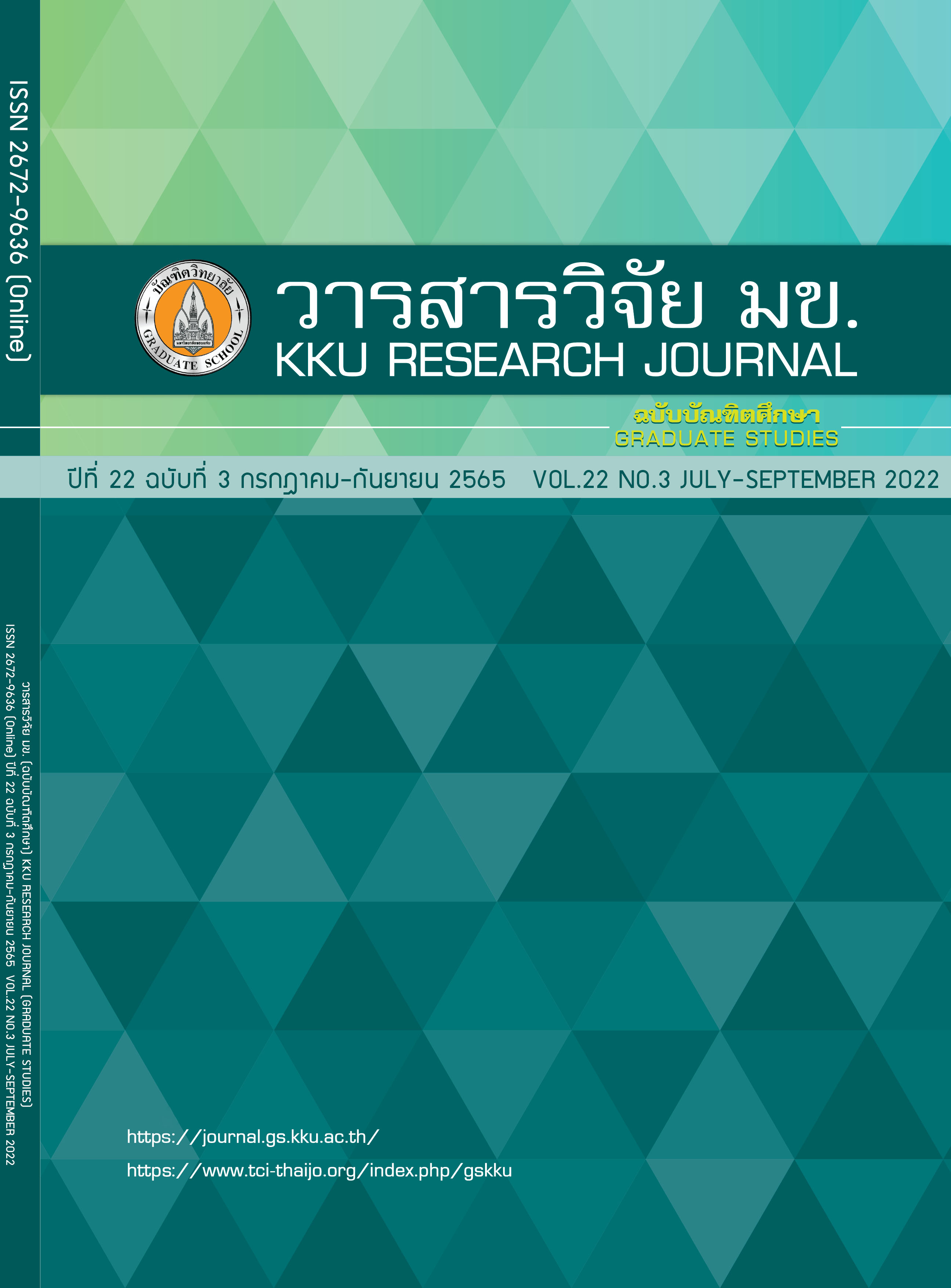The Correlation Between Productivity and Heat Exposure of Sugarcane Farmers in Nongbuadaeng District, Chaiyaphum Province
Keywords:
Working Environment, Productivity, Sugarcane farmersAbstract
This cross-sectional descriptive study aimed to investigate the correlation between the productivity and heat exposure in different seasons of sugarcane cutters who is sugarcane farmers in Nongbuadaeng district, Chaiyaphum province. The study was conducted 2 seasons from January (winter) and February (summer) 2021. Data were collected by using: 1) Wet Bulb Globe Thermometer (WBGT) for temperature WBGT measurement 2)The questionnaire of information about working time and productivity. Data were analyzed by using descriptive statistics and Pearson’s correlation and Spearman's rank correlation. The findings show that, the lowest WBGT which was found in winter was 30.2 ºC and highest WBGT which was shown in summer was 31.2 ºC caused the low to medium risk of heat stress compared to the Workplace Safety and Health standard, Singapore (the risk level of heat stress is classified with WBGT, i.e., Low: < 31 ºC, Medium: 31 ºC – 31.9 ºC, and High: ≥32 ºC). During winter, sugar cane cutter could produce bundles of sugar cane in the range of 100-150 bundles (55.15%), less than 100 bundles (23.48%) and in average of 126 bundles (SD=43.17, median=120, min=15, max=253). Furthermore, in summer, the bundles of sugar cane were mostly in the range of 100-150 bundles (53.56%), more than 100 bundles (24.54%) and in average of 130 bundles (SD=49.33, median=130, min=12, max=350) which was higher productivity compared to the winter period because of high demand from the factory. For the relationship between productivity and WBGT in summer, it was found that an increased productivity was significantly associated with a decrease of heat or WBGT (p-value = 0.008). The result could suggest for farmers to have break under good wind flow and more water or fluid drinking to prevent heat stress and performing risk assessment to reduce the productivity impact.
References
Office of the cane and sugar board. Report on sugarcane planting situation 2020/2021 [Internet]. 2021 [cited 2021 May]. Available from https://1th.me/BS3zp
Prachachat Business Online. Sugar cane production in 2021/2022 has increased by 90 million tons, the government guarantees the purchase price of 1,000 baht per ton. [Internet] 2021 [cited 2021 June 30]. Available from https://1th.me/qGDdq
Chaiyaphum provincial office. Strategic and information work group for provincial development. Chaiyaphum provincial development plan 2018-2021. [Internet] 2016 [cited 2020 August 3]. Available from https://1th.me/encBa
Office of the cane and sugar board. Report of sugarcane planting area for the year 2016/17. [Internet] 2016 [cited 2020 August 3]. Available from https://1th.me/iDDjT
Office of the cane and sugar board. Report on sugarcane production in Thailand for the year 2017/18. [Internet] 2017 [cited 2020 August 3]. Available from https://1th.me/ib6aF
Chaiyaphum provincial agriculture and cooperatives office. Sub – district and agricultural area Chaiyaphum province. [Internet]. 2020 [cited 2020 February 11] Available from https://1th.me/eKKKF
National News Bureau of Thailand. Sugarcane workers live economically. to send money home. [Internet] 2019 [cited 2021 October 27]. Available from https://1th.me/LMbu0
Tantipanjaporn T. Heat: health effects, measurement, standard and heat acclimatization. J Safety & Health. 2019; 11(3): 1-15. Thai.
Sabchangreed T, Inmoung U. Farmer’s heat related illness in Takhop sub-district, Pakthongchai district, Nakhon Ratchasima Province. KKU J Public Health Res. 2016; 9(2): 53-59. Thai.
Langkulsen U, Vichit-Vadakan N. Effects of climate change and heat exposure among agricultural and industrial workers in Thailand. Sci & Technol J. 2018; 26(4): 680-693. Thai.
Pour MRME, Hajizadeh R, Beheshti MH, Kazemi Z, Zonazzam M. Loss of productivity due to heat exposure among Iranian outdoor workers. Int J Occup Hygiene. 2016; 8(2): 62-68.
Sadiq LS, Hashim Z, Osman M. The impact of heat on health and productivity among maize farmers in a tropical climate area. J Environ Public Health. 2019; 2019: 1-7. https://doi.org/10.1155/2019/9896410
Boonruksa P, Maturachon T, Kongtip P, Woskie S. Heat stress, physiological response, and heat-related symptoms among Thai sugarcane workers. Int J Environ Res Public Health 2020; 17(17): 6363. https://doi.org/10.3390/ijerph17176363
Silpcharu T. Research and statistical analysis with SPSS. Bangkok: V Inter Print; 2005. Thai
Ministry of Labour. Guidelines for compliance with ministerial regulations set standards in the administration and management of safety. Occupational health and work environment related to heat, light and sound 2006 [Internet]. 2006. [cited 2020 August 22] Available from https://1th.me/tskop
Ministry of Labour. Ministerial regulations prescribing standards for the administration, management and operation of safety Occupational health and work environment related to heat, light and sound 2016 [Internet] 2020. Available from https://1th.me/vpgX4
Department of Alternative Energy Development and Effiency. Wind power in the Encyclopedia of Alternative Energy. 2014 [Internet]. 2020. Available from https://1th.me/PqNR8
Radir AF, Hashim Z, Phan K, Sao V, Hashim JH. The impact of heat on health and productivity among sugarcane workers in Kampong Cham, Cambodia. Asia Pac Environ Occup Health J. 2017; 3(1): 9-19
Dally M, Butler-Dawson J, Krisher L, Monaghan A, Weitzenkamp D, Sorensen C, et al. The impact of heat and impaired kidney function on productivity of Guatemalan sugarcane workers. PLoS One. 2018; 13(10). https://doi.org/10.1371/journal.pone.0205181
Krishnamurthy M, Ramalingam P, Perumal K, Kamalakannan LP, Chinnadurai J, Shanmugam R, et al. Occupational heat stress impacts on health and productivity in a steel industry in Southern India. Saf Health at Work. 2017; 8(1): 99-104. https://doi.org/10.1016/j.shaw.2016.08.005
Downloads
Published
Issue
Section
License
Copyright (c) 2022 KKU Research Journal (Graduate Studies)

This work is licensed under a Creative Commons Attribution-NonCommercial-NoDerivatives 4.0 International License.



